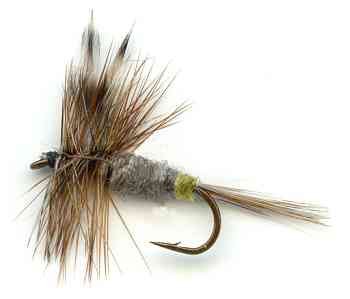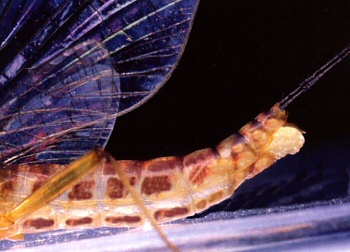The Female Adam's Dry Fly
The Adams dry fly is one of the most popular North America original dry fly patterns. This version is the Female Adams with its yellow egg sack ready to lay eggs into the water through the surface film as shown in the photograph below.

DRY FLY PATTERNS. Hook size 12 14 16 18 20 24 - $US each
The Female Adams Dry Fly pattern can be used in a variety of waters, to imitate food items almost anywhere trout are found. It can be tied in various sizes to represent either mayfly dun or midge adults.
In the life cycle of the Mayfly, the Dun splits is skin and crawls out as the mature adult mayfly. This is properly called the imago stage but most fly fishermen call them mayfly spinners. This change process takes a couple of days for the larger species but it can just take a few seconds for the smaller ones.
Some of the newly transformed spinners have stronger colored bodies. Their wings are normally transparent. Their tails are longer than the Dun stage tail. When the Spinners external skeleton has hardened it can fly off and look for a mate. This transformation does not happen on the water so is of little importance to the angler. What is important are the physical changes that occur in the body shape and color.

Use the Adam's Female Dry fly to imitate an egg laying mayfly
Along river banks, near lakes and over water male mayfly spinners can be observed swarming. They flutter up and down in the swarm column waiting for a female to enter the area. As soon as she arrives mating occurs in the air. Some pairs loose the ability to stay in the air whilst joined. They fall to the ground. If they are over the water they can drown. The pair separate and fly off in different directions.
The female heads towards water. She must briefly land on the water surface to lay her impregnated eggs by dipping the yellow egg sack at the end of her body into the water.
This is a very risky manoeuvre for the females as the trout are hungry and waiting under the surface to attack. Some female mayfly spinners belonging to the Baëtis group of mayflies crawl beneath the water surface and attach their eggs on sunken branches and aquatic plants. Many don't complete this task as they are picked off by hungry waiting trout. Mayflies that have this suicidal tendency are some of the flies that are important to fly fishing. They include Pale Watery, Large Dark Olive and the Iron Blue female Spinner
Many female mayflies lay their eggs by dipping down onto the water surface and depositing their eggs from the rear of their body. A good tactic is to try and cast your fly so it lands near but slightly behind a surface feeding trout. These fish know they have to be quick to catch these egg laying females before they take off again.
The trout has a turning reflex movement that will spring into action as soon as it spots your fly land. What is cunning about this approach is that the trout will not have time to see your leader which helps in popular fly fishing waters where fish get suspicious and spooked.
Dry fly only fly fishing?
What do we mean by the term 'Dry Fly'? The problem is that different fly fishermen, fishery owners, fly fishing clubs and fishing lodges have different definitions.
Does it refer to an artificial fly that floats in or only on the surface film? It is always best to ask before falling fowl of any fly fishing rules that govern 'dry fly' only stretches of water.
You can split floating flies into several categories that relate to insects at different stages of hatching. The traditional dry fly floats on top of the surface film and imitates mayfly duns, adult midges and caddis that are standing on the surface film waiting for their wings to dry before taking off.
Moist or damp flies imitate a fly that sits or lies in the surface film swimming, dying or egg laying. This group also included waterlogged drowning terrestrials like grass hoppers, beetles, ants and daddy longlegs.
A fly that imitates a nymph or pupae that is resting, hanging from the surface film, just before starting to hatch is called a suspender fly. John Goddard's Suspender Buzzer is a good example of this type of fly pattern.
An emerger fly pattern, like a Klinkhammer, imitates the natural insect that has started to hatch and has passed through the surface film and is discarding its old body.
The common thing about all these type of flies is that they float in, on or from the surface film. They are visible on the water surface and the fish rise to them. They are all imitate a stage in an insects development or its death.
I believe they should all be accepted as floating dry flies. As a fly fisherman you are trying to catch fish that are rising to the surface to find their food but not everyone takes the same view. It is always wise to ask what fly is acceptable for use on a dry fly only stretch of water before you start to fish.
If you find you are fishing on a strict, on top of the surface film, dry fly imitation pattern only stretch of river or fishery lake there is a way to cheat if you find the fish are being selective and taking emerging or hanging flies only. Thin the hackles on your dry fly. Get rid of any grease on your fly by rubbing in dry mud or a cloth then drown your dry fly. You will find you dry fly no longer sits so proud on the surface and even dips below the surface film. If asked what fly you are using you are still using a dry fly!
Customer's Comment
I have just watched the most amazing TV program by Richard Attenborough on insect life. A female mayfly, as she oviposit (lays eggs), flies upstream taking many factors into account (breeze direction and speed, current speed, river depth etc) to a point where she knows her eggs will be carried downstream to the point where she hatched on the river bed! That lovely film, 'A River Runs Through it', uses a term I had not come across in my many decades of fly-fishing - 'shadow-casting'. Soon after I saw the film I tried the tactic, whereby you 'false cast' over a likely spot to get the trout interested.
It sees a fly moving around just above the surface, preparing to oviposit (lay eggs). After three or four 'false casts' allow the fly to alight on the surface - and bam! Here's an amazing piece of natural science: the female Mayfly flies upstream to oviposit, taking many factors into account, such as current speed, river depth, wind direction and even surface tension. When she's happy all is right she deposits her eggs so that they settle on the river bed downstream where she has just spent a year of her life! Amazing, or what!? What an amazing pursuit we enjoy! BTW lovely tying! Gregor Fulton McGregor HK www.mcgregorfly.com

